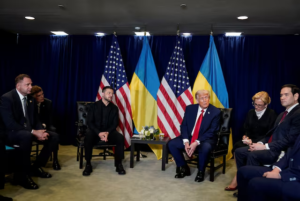United States President Donald Trump reignited clashes with Beijing on Friday, putting an end to months of fragile peace between the world’s two largest economies. In a move that sent global markets tumbling, Trump introduced sweeping new tariffs and technology export prohibitions in retaliation for China’s latest limits on rare earth mineral exports.

The White House declared plans to impose 100% tariffs on all Chinese exports to the U.S., as well as strict export controls on important American software and technology. The measures will take effect by November 1, just days before the existing tariff relief agreement is due to expire.
Trump was responding directly to Beijing’s step earlier this week to expand its export restrictions on rare earths, a category of minerals essential to the production of electric cars, advanced weaponry, smartphones, and other high-tech gear. China already dominates over 90% of the world’s rare earth refining and magnet production, making it a chokepoint in the global supply chain.
“This was a surprise,” Trump told reporters at the White House. “China’s actions are very, very bad for the world economy—and we have no choice but to do something about it.”
Uncertain Future for Trump-Xi Meeting
The escalation in trade rhetoric has thrown into question a meeting between Trump and Chinese President Xi Jinping, which was originally supposed to take place in South Korea later this month during the Asia-Pacific Economic Cooperation (APEC) summit.
There is no need to do that at this moment,” Trump posted on his Truth Social media network. But he soon backtracked, clarifying that the meeting was not officially cancelled, stating, “I would think we can still have it.”
Beijing has not said whether Xi will go or meet Trump amid rising tensions.
Markets React Sharply to Tariff Shock
Global financial markets reacted swiftly to Trump’s words. The S&P 500 Index dropped over 2%, its largest one-day drop since April, with technology and manufacturing stocks at the forefront of the decline.
Investors sought refuge in gold and U.S. Treasury bonds, and the U.S. dollar declined against major global currencies.
The president’s move could mark the end of the brief tariff truce between Washington and Beijing,” said Craig Singleton, senior fellow at the Foundation for Defense of Democracies. “China’s export bans were seen in Washington as a direct provocation—and now both sides are retaliating.”
Key Software Ban Could Hit China’s Tech Industry
Analysts have said U.S. export curbs on “critical software” would be a crippling blow to China’s technology sector, particularly in areas like artificial intelligence, cloud computing, and semiconductor design—fields that depend heavily on U.S. software and hardware.
Trump also threatened additional curbs on aircraft exports and aircraft parts, indicating a possible escalation that would impact Boeing, a leading U.S. exporter to China.
An individual familiar with internal discussions said the administration was developing “a list of possible future targets,” including sensitive sectors like quantum computing, 5G technology, and renewable energy systems.
China’s Retaliation and Global Implications
China’s Ministry of Commerce recently added five more rare earth elements and several refining technologies to its restricted exports list. The new rules also bring foreign companies that utilize Chinese materials under Beijing’s export requirements—a move that most analysts view as a strategic response to Western semiconductor bans.
Beijing has repeatedly condemned Washington’s interventions as “unilateral protectionism,” accusing the U.S. of destabilizing global trade. American officials, however, argue that China’s dominance in rare earth production has long posed a national security and supply chain risk.
The U.S. Federal Communications Commission (FCC) announced on Friday that some of the biggest online retailers had been instructed to remove millions of listings of Chinese-made electronics that are banned, citing security risks.
Rising Stakes Ahead of APEC Summit
With the APEC Summit due to begin on October 31, both nations appear to be preparing for a high-stakes diplomatic showdown.
Both sides are pushing the limits,” said Scott Kennedy, a senior China specialist at the Center for Strategic and International Studies (CSIS). “Either they’re ratcheting up pressure to squeeze concessions before APEC, or they’ve decided a deal is impossible and are bracing for a new era of conflict.
As trade hostilities intensify, analysts warn the resurgent battle could derail global supply chains, drive up consumer costs, and imperil economic recovery efforts worldwide.
For now, Trump is not deterred: “For every product China has, America has two alternatives,” he said. “We will not be hostage to any country that would try to use resources vital to our national and economic security.”.




